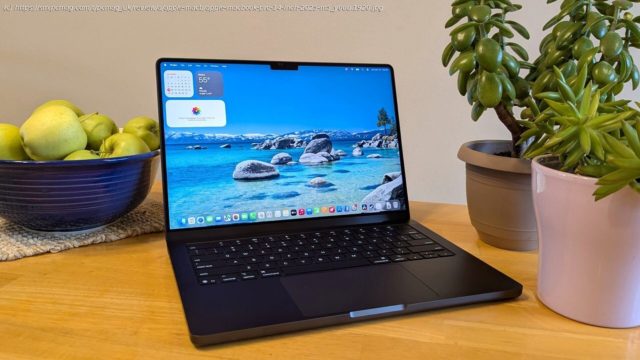The 2025 MacBook Pro 14-Inch looks identical to its predecessor, but the M5 chip delivers vastly amped-up AI and graphics muscle, vaulting Apple’s « basic » power MacBook into a new class of mighty machine.
With the new M5-powered MacBook Pro 14-inch, Apple’s 2025 refresh has the same looks, the same features, and most of the same parts as last year’s M4 version. You’d be forgiven for thinking it’s not that different—but leave it to Apple to turn a minor update into a major leap forward.
New laptop models tend to fall into one of two categories: those with major redesigns (essentially making an all-new laptop that keeps the name of a successful model), and those with smaller internal hardware bumps, where the laptop stays much the same but gains a newer processor or other component. The 2025 MacBook Pro 14-Inch (which starts at $1,599; $2,349 as tested) looks exactly like the previous model. But those similarities don’t tell the story at all.
Instead, the M5 chip turns Apple’s floor-level pro-grade Mac laptop into a surprisingly powerful machine for pretty much anything, including gaming. With tuned-up processor cores, more memory bandwidth, and graphics silicon turbo-charged with AI acceleration, it’s a step forward that’s more than just incremental—it vaults past what we expected generation to generation, earning it our Editors’ Choice award for compact content creation laptops.Configurations: New Loadouts, Old Pricing
Since all that’s new with this M5 MacBook Pro is the processor, it should come as no surprise that the base model sells for the same $1,599 as the previous M4’s. For that price, you get the M5 processor, a 10-core GPU, 16GB of unified memory, and a 512GB SSD.
Apple offers a few preset configurations: for example, one with the same CPU, GPU, and 16GB of unified memory, but a 1TB SSD, for $1,799. Or you can step up to 24GB of unified memory and 1TB of storage for $1,999.
Our own review unit was outfitted with 32GB of memory (a $400 uptick), a 1TB SSD ($200), and Apple’s nano-texture screen-glass option ($150) for a grand total of $2,349. If you really want to go wild, you can scale the storage up to 2TB or 4TB, with the top configuration selling for $3,349.The M5 Chip: 2025’s Been a Big Year for Apple Silicon
The engine for the hotrod. The rocket carrying the shuttle. The brains behind the operation. Whatever metaphor you want to use, the whole 2025 MacBook Pro upgrade is the move from M4 to M5, the fifth generation of Apple’s M-series chips.
Apple isn’t messing around with this update. The M5 hews pretty closely to the same template that the M4 chip did: a 10-core CPU (with four high-performance cores and six high-efficiency cores), a 10-core GPU, and a 16-core Neural Engine to accelerate AI workloads, all sharing the same pool of Unified Memory. But that’s where the similarities end.
Those 10 CPU cores have grown more efficient and more capable, thanks to Apple’s third-generation 3-nanometer (nm) manufacturing process. The GPU cores are enhanced with boosted shader cores, third-generation ray-tracing hardware, and dynamic on-chip caching for a general boost in performance.
But the most significant change of all is the Neural Accelerator added to each graphics core. This change uses the technology from the AI-focused Neural Engine, adding it to each of the 10 GPU cores, providing boosted AI capabilities and a significant acceleration of graphics performance. (Both delivered eye-popping results in our graphics and AI performance tests.)macOS ‘Tahoe’: Liquid Glass and Smarter AI
The other major change is to the software, with the introduction of macOS 26, codenamed « Tahoe. » The 2024 MacBook Pro came with macOS « Sequoia » 15. With Tahoe, Apple has switched from a sequential numbering scheme for each new version of macOS to numbering by the year of release. Sequoia introduced some usability enhancements, like iPhone mirroring, split-screen management, presenter tools for video calling, and dozens of improvements for native Mac apps. But the biggest enhancement Sequoia brought was Apple Intelligence, a new suite of AI-powered features and utilities.
Tahoe takes that AI ball and runs with it, adding on-device features like Live Translation in Messages, Phone, and FaceTime. Other features include Genmoji and Image Playground. Shortcuts are more potent with new intelligent actions, letting you automate actions and even string them together for automated workflows.
It also looks a bit different, with the new Liquid Glass design, making elements like the Dock, menu bar, and app windows more vibrant. If you’ve seen the latest iPhones, this is the same visual makeover that iOS got earlier this year.
Features like Continuity and Spotlight also enjoy improvements, with new ways to work across devices, like menu bar notifications for your phone apps and the new Phone app for Mac, which lets you make calls on your iPhone from your Mac, going a step beyond the simple mirroring feature of Sequoia. And with the improved Spotlight Search, you can find apps, files, settings, and more from a single system-wide search, and even take actions right in that search, doing things like sending messages, creating an event, and running shortcuts.
Apple has also spruced up the Apple Games app, adding in-game events, a wider game library, and a new game overlay for settings adjustments without leaving the game. But the most considerable improvement might be the addition of MetalFX Frame Interpolation, which uses AI built into the GPU cores to generate new, additional frames between the originally rendered frames to boost the frame rate while you play, making for a faster, smoother experience. This feature directly rivals technologies like Nvidia’s Deep Learning Supersampling (DLSS) and AMD’s FidelityFX Super Resolution (FSR).Design: A Classic, Unmodified
That’s all stuff that changed, but let’s be honest, if you were looking right at the new MacBook Pro, it has nothing to tell you that you’re seeing a new model versus the older 2024 version. From the shiny Apple logo to the « MacBook Pro » written on the underside of the chassis, these aren’t just similar-looking laptops; it’s the same chassis. That aluminum chassis measures the same 0.61 by 12.3 by 8.7 inches, weighs the same 3.4 pounds, and is available in either Silver or Space Black finishes—exactly the same.
What else is the same? The keyboard and trackpad, to start. The backlit keyboard is (for better or worse, depending on preference) the same one used in the 2024 MacBook Pro 14-incher, right down to the Touch ID fingerprint reader in the power button. The touchpad is still big and smooth, and the haptic feedback still feels exquisite. If anyone remembers Force Touch (Apple’s pressure-sensitive contextual controls), that’s still part of the trackpad experience, as well.
Apple’s display is also the same, right down to the 3,024-by-1,964-pixel resolution, but with one minor tweak: The 14.2-inch Liquid Retina XDR display can now boost the mini LED backlight to provide brighter SDR performance in bright ambient light—up to 1,000 nits of brightness for SDR content—along with the vibrant color, crisp details, and superb HDR support.






